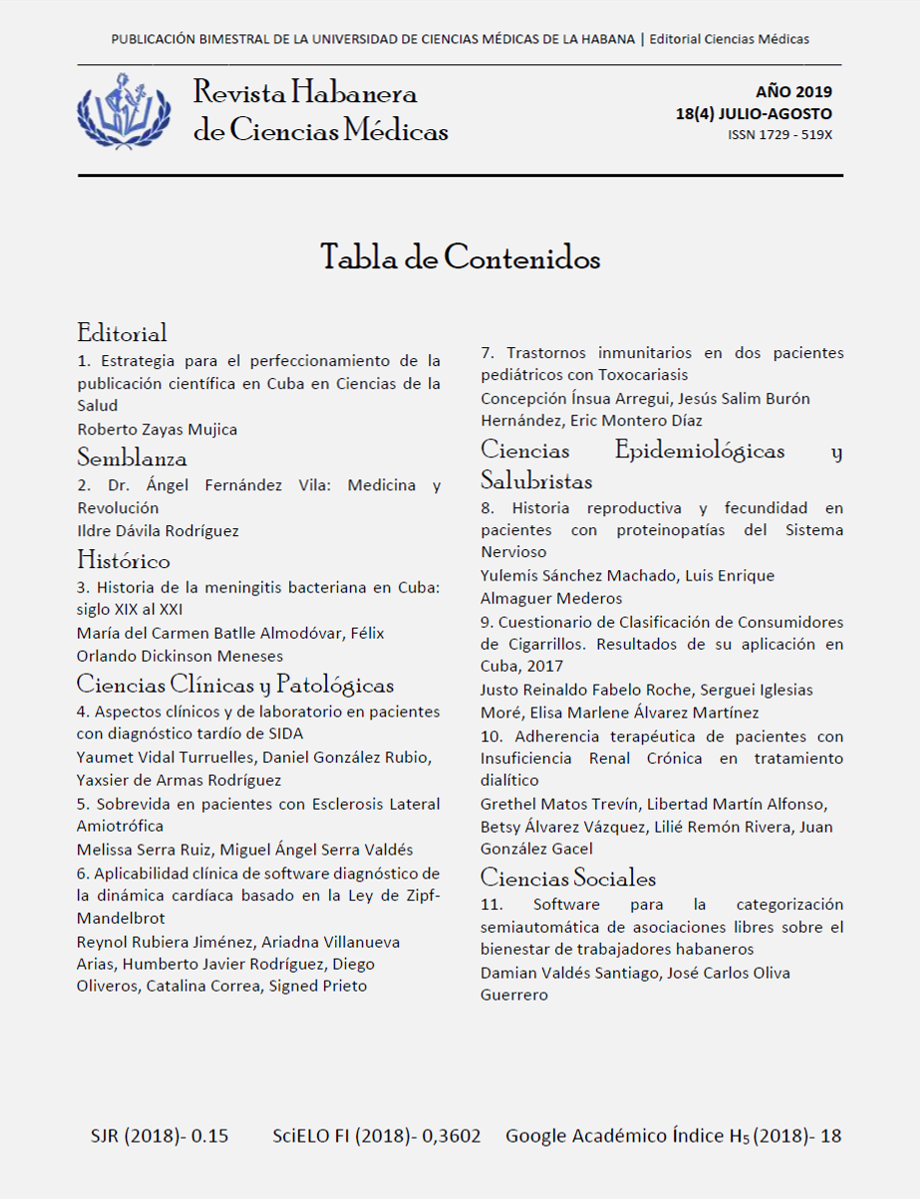Software for semi-automatic categorization of free associations to promote the welfare of workers of Havana
Keywords:
análisis de contenido, análisis asistido de datos cualitativos, minería de texto, bienestar humano, asociaciones libres, índice de concordancia Kappa.Abstract
Introduction: Experts of the Faculty of Psychology of the University of Havana proposed the Personal, Labor and Social Human Well-being questionnaire (BHPLS, in Spanish), that was applied to 135 Cuban workers of three social and occupational groups. Given the variety of responses, a content analysis (CA) was used for Question 1 of the mentioned questionnaire.
Objective: To present and implement a software that allows a semi-automatic categorization in a CA used for this question.
Material and Methods: The Kappa index test was used to evaluate experts´ agreement with respect to category schemes. We implemented a software with the Python programming language to achieve our objective, considering other similar software functionalities.
Results: We implemented, validated and registered the software BHPLS data processing-UH® that allows to set up a categories system, load the collected data, categorize associations in a semi-automatic way, and save the results, among other functionalities. This software was validated by Psychology students and, when they performed the manual categorization, a negative Kappa agreement index (low categorization agreement between experts) was obtained whereas using the proposed software, a global Kappa index of 0.7871 with p=0.00 (high and statistically significant categorization agreement between experts) was obtained. Besides, we proposed a unified algorithm for expert’s categorizations, and carried out a Correspondence Analysis (ANACOR) on the basis of the categorizations achieved.
Conclusions: According to the high concordance attained, we recommend the software due to its adaptability, ease of use, and “humanization'' of the process. The CA allowed us to observe similarities in social and occupational groups. The software functionalities can be applied for processing free associations in other scenarios.
Keywords: content analysis, qualitative data analysis, text mining, human welfare, free associations, Kappa index test.
Downloads
References
1. Neuendorf KA. The content analysis guidebook [Internet]. Second edition. 2017 [cited 2019 Mar 8]. 438 p. Available from: https://us.sagepub.com/en-us/nam/the-content-analysis-guidebook/book234078
2. Jenny J. Méthodes et pratiques formalisées d’analyse de contenu et de discours dans la recherche sociologique française contemporaine. Etat des lieux et essai de classification. Bull Méthodologie Sociol. 1997;54:64–112.
3. Lahlou S. A method to extract social representations from linguistic corpora. Japanese J Exp Soc Psychol. 1996;35(3):278–391.
4. de Rosa AS. The associative network: A technique for detecting structure, contents, polarity and stereotyping indexes of the semantic fields. Eur Rev Appl Psychol. 2002;3–4:81–200.
5. Woolf NH, Silver C. Qualitative analysis using ATLAS.ti: the five-level QDA method [Internet]. Routledge; [cited 2019 Mar 8]. 194 p. Available from: https://www.routledge.com/Qualitative-Analysis-Using-ATLASti-The-Five-Level-QDA-Method/Woolf-Silver/p/book/9781138743656
6. Woolf NH, Silver C. Qualitative analysis using nvivo: The five-level QDA® method. Qualitative Analysis Using NVivo: The Five-Level QDA Method. London: Routledge, 2017 [cited 2019 Mar 8]. Available from: https://www.routledge.com/Qualitative-Analysis-Using-NVivo-The-Five-Level-QDA-Method/Woolf-Silver/p/book/9781138743670
7. Noriega Rodríguez A. Cuestionario que estudia el bienestar humano como constructo multidimensional. Caso de Estudio: Relación entre Bienestar y Trabajo. Trabajo de Diploma presentado en opción al título de Licenciado en Psicología. Tutores: Maiky Díaz Pérez, Marta Martínez Rodríguez y Damian Valdés Santiago. Universidad de La Habana; 2018.
8. Díaz-Pérez M, Valdés-Santiago D. Desarrollo del potencial humano y bienestar en el trabajo. In: Ferreira M, editor. Intensificação, Precarização, Esvaziamento do Trabalho e Margens de Enfrentamento, “GT Trabalho e Saúde’’’.” Associação Nacional de Pesquisa e Pós-Graduação (ANPEPP), Brasil; 2018.
9. Krippendorff KH. Content Analysis: An Introduction to Its Methodology. 4th ed. Los Angeles: SAGE, 2019. Available from: https://us.sagepub.com/en-us/nam/content-analysis/book258450
10. Tang W, Hu J, Zhang H, Wu P, He H. Kappa coefficient: a popular measure of rater agreement. Shanghai Arch psychiatry [Internet]. 2015 Feb 25 [cited 2019 Mar 8];27(1):62–7. Available from: https://www.ncbi.nlm.nih.gov/pmc/articles/PMC4372765
11. Greenacre M. Correspondence Analysis in Practice. 3rd edition. Boca Raton: CRC Press, Taylor & Francis Group, 2017. [cited 2019 Mar 8] Available from: https://www.crcpress.com/Correspondence-Analysis-in-Practice/Greenacre/p/book/9781498731775
12. Fleiss JL, Levin B, Paik MC, Fleiss J. Statistical Methods for Rates & Proportions. 3rd ed. New York: Wiley-Interscience; 2014. [cited 2019 Mar 8] Available from: https://www.wiley.com/en-cu/Statistical+Methods+for+Rates+and+Proportions%2C+3rd+Edition-p-9780471526292
13. Romano F. Learn Python programming: a beginner’s guide to learning the fundamentals of Python language to write efficient, high quality code [Internet]. Second edition. 2018 [cited 2019 Mar 8]. Available from: https://www.packtpub.com/application-development/learn-python-programming-second-edition
14. Summerfield M. Rapid GUI programming with Python and Qt : the definitive guide to PyQt programming [Internet]. [Place of publication not identified]: Prentice Hall; 2015 [cited 2019 Mar 8]. Available from: https://www.oreilly.com/library/view/rapid-gui-programming/9780132354189/
15. Gazoni E, Clark C. openpyxl: A Python library to read/write Excel 2010 xlsx/xlsm files. 2018.
16. Guerrero-Oliva JC, Valdés-Santiago D. Software para el Análisis de Contenido de nociones de bienestar en una aplicación del cuestionario BHPLS. En: X Encuentro de Estudiantes de Psicología. La Habana, Cuba: ISBN 978-959-16-3917-2; 2018.
17. Oliva Guerrero JC, Valdés Santiago D. BHPLS data processing-UH®. Número de registro 2984-09-20, Centro Nacional del Derecho de Autor, La Habana, Cuba, 2018.
18. StatSoft, I. (2017). STATISTICA (data analysis software system), version 8.0.



